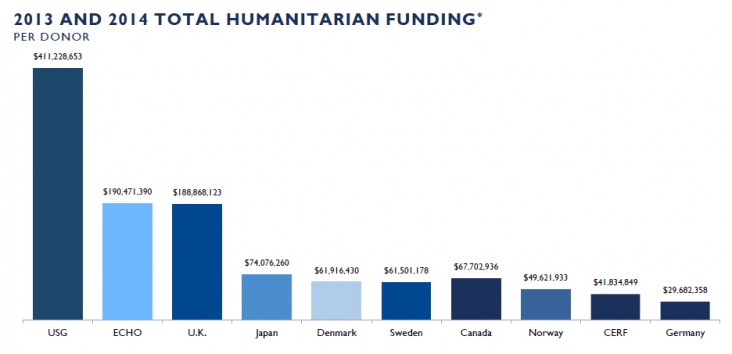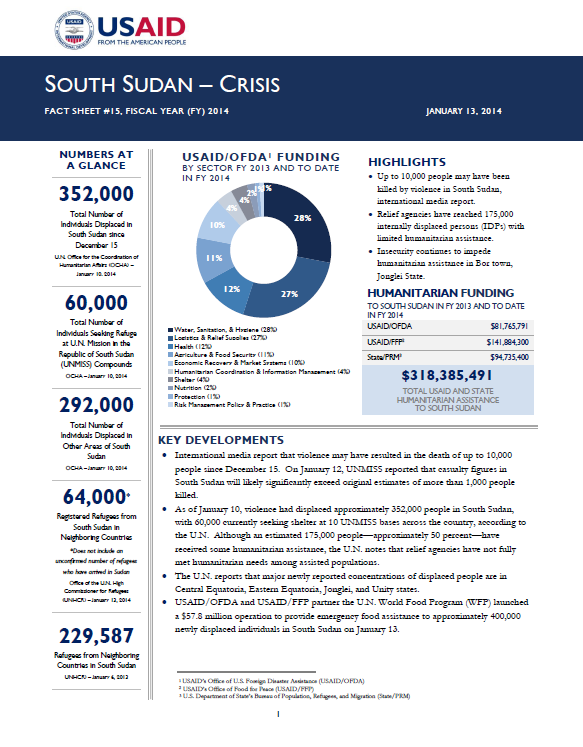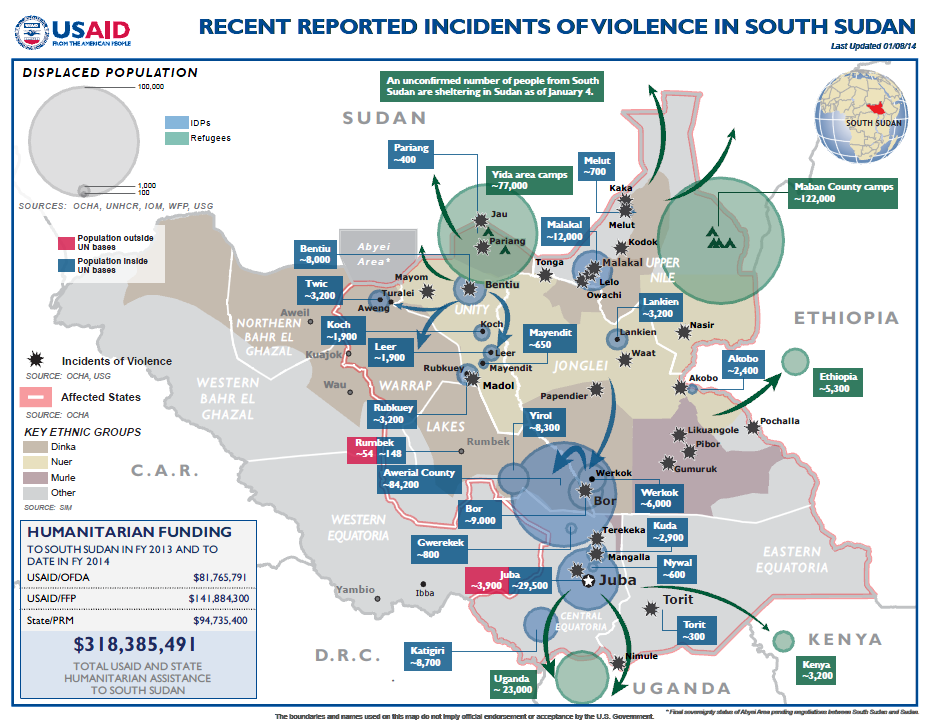- What We Do
- Agriculture and Food Security
- Democracy, Human Rights and Governance
- Economic Growth and Trade
- Education
- Environment and Global Climate Change
- Gender Equality and Women's Empowerment
- Global Health
- Humanitarian Assistance
- Transformation at USAID
- Water and Sanitation
- Working in Crises and Conflict
- U.S. Global Development Lab
Speeches Shim
January 13, 2013
Numbers At A Glance
352,000
60,000
292,000
64,000
229,587
Humanitarian Funding:
To South Sudan To Date In FY2013 and FY2014:
| USAID/OFDA | $81,765,791 |
| USAID/FFP | $141,884,300 |
| State/PRMDoD | $94,735,400 |
| TOTAL | $318,385,491 |
Highlights
Up to 10,000 people may have been killed by violence in South Sudan, international media report.
Relief agencies have reached 175,000 internally displaced persons (IDPs) with limited humanitarian assistance.
Insecurity continues to impede humanitarian assistance in Bor town, Jonglei State.
KEY DEVELOPMENTS
International media report that violence may have resulted in the death of up to 10,000 people since December 15. On January 12, UNMISS reported that casualty figures in South Sudan will likely significantly exceed original estimates of more than 1,000 people killed.
As of January 10, violence had displaced approximately 352,000 people in South Sudan, with 60,000 currently seeking shelter at 10 UNMISS bases across the country, according to the U.N. Although an estimated 175,000 people—approximately 50 percent—have received some humanitarian assistance, the U.N. notes that relief agencies have not fully met humanitarian needs among assisted populations.
The U.N. reports that major newly reported concentrations of displaced people are in Central Equatoria, Eastern Equatoria, Jonglei, and Unity states.
USAID/OFDA and USAID/FFP partner the U.N. World Food Program (WFP) launched a $57.8 million operation to provide emergency food assistance to approximately 400,000 newly displaced individuals in South Sudan on January 13.
SITUATION AND DISPLACEMENT UPDATE
Ongoing hostilities in many areas of South Sudan continue to impede the delivery of critical humanitarian assistance to vulnerable populations. Despite constraints, humanitarian agencies are providing support as access and security allow.
The U.N. reports that heavy fighting spread to Central Equatoria State on January 9 and 10, but left Bor town relatively calm. Sporadic gunfire around Bor and the fluid security situation continue to hamper humanitarian access in Bor.
The U.N. also reported that heavy fighting occurred in Rubkona and Bentiu towns, Unity State, on January 10. In anticipation of the violence, aid agencies observed large-scale movements of civilians, preemptively fleeing violence in Unity. An estimated 10,000 people from the towns moved towards Leer County, while additional populations have sought refuge at the Bentiu UNMISS compound.
South Sudan Crisis Fact Sheet #15 January 13, 2014 ![]() (pdf - 403k)
(pdf - 403k)
HUMANITARIAN RESPONSE IN JUBA, CENTRAL EQUATORIA STATE
At the two UNMISS bases in Juba—Tong Ping and U.N. House 3—the International Organization for Migration (IOM) is coordinating the delivery of emergency shelter and relief item distribution for IDPs. As of January 11, humanitarian agencies have distributed relief item kits—including blankets, mosquito nets, sleeping mats, soap, and water containers—to more than 28,000 people at UNMISS Tong Ping and U.N. House 3. At Tong Ping, relief agencies erected a total of more than 60 tents capable of sheltering up to 50 people each.
Insufficient space at both UNMISS Juba sites remains a concern. The U.N. estimates that up to 400 new people arrive at the two bases daily. The U.N. reports that new arrivals at the Tong Ping site are transferred to the slightly less crowded U.N. House 3 and are registered there upon arrival.
At U.N. House 3, relief agencies are providing displaced populations 13 liters of water per day and plan to meet Sphere1 standards in the coming weeks. Although overcrowding at the Juba sites has limited the space available to construct additional sanitation facilities, relief agencies are also working to double the number of latrines for IDPs at the two UNMISS Juba compounds.
As of January 10, WFP had commenced second-round of food distributions at U.N. House 3, initially reaching more than 9,800 people.
The U.N. reports that mine action relief agencies began removing unexploded ordnance in areas of Juba affected by fighting.
The Education Cluster—the coordinating body for humanitarian education activities, comprising U.N. agencies, NGOs, and other stakeholders—in Juba is assisting more than 300 students, including approximately 40 girls, to take primary school exams in mid-January. In addition, U.N. education partners are providing materials, including chairs, desks, pens, and pencils in preparation for the exams, as well as facilitating space for testing.
South Sudan Crisis Map January 13, 2014 ![]() (pdf - 421k)
(pdf - 421k)
HUMANITARIAN NEEDS AND RESPONSE IN OTHER AREAS OF SOUTH SUDAN
The fluid security situation continues to hamper aid activities to Bor, where humanitarian organizations remain unable to secure safety assurances needed to commence flights into the town. Despite the volatile security situation, a U.N. partner is working to provide basic water, sanitation, and hygiene (WASH) services to the estimated 9,000 IDPs at the UNMISS compound in Bor. Hygiene awareness campaigns—critical to the prevention of disease, as sanitation facilities are limited—are continuing at the UNMISS Bor site.
Security conditions in Malakal town, Upper Nile State, remain calm but tense. Relief agencies are registering the estimated 12,000 civilians sheltering at the UNMISS base to improve displacement tracking and assess humanitarian need. The U.N. reports that Malakal Hospital—the only operational health care facility in Malakal town—is experiencing shortages of blood and transfusion supplies and notes that more than 190 patients await surgery, pending the availability of supplies needed. IOM is pre-positioning drugs and other medical supplies from existing stock in Juba to warehouses in Malakal.
During the week of January 5, the Logistics Cluster facilitated the airlift of 4 metric tons of health and WASH supplies to the Minkamman area in Awerial County, Lakes State, where an estimated 84,200 displaced people are sheltering. In Awerial, Oxfam trained approximately 40 community hygiene promotion volunteers who are delivering hygiene messages to IDPs on a daily basis. The Camp Coordination and Management Cluster, Doctors with Africa (CUAMM), and Médecins Sans Frontières continue to provide primary health care services in Awerial, while USAID/OFDA partners the U.N. World Health Organization (WHO) and the U.N. Children’s Fund (UNICEF) are providing medical supplies and administering vaccinations.
The U.N. reports the need for emergency relief supplies and shelter materials in many affected areas, including at the UNMISS Base in Bentiu and Malakal, as well as in Waat, Jonglei State. An interagency rapid needs assessment conducted in Bentiu on January 5 and 6 noted severe overcrowding and a lack of basic infrastructure—including adequate latrines and drainage channels—at the UNMISS site, where more than 8,000 people are seeking shelter. UNMISS reports the situation in the camp is tense, in part due to outstanding health, protection, shelter, and WASH needs. On January 10, WFP began transporting food from its warehouse in Benitu to the UNMISS compound.
Relief agencies distributed one-month food rations and relief items to IDPs in Twic County, Warrap State, where approximately 3,200 people are seeking shelter.
USAID/OFDA partner the U.N. Food and Agriculture Organization (FAO) reports that recent violence has significantly affected the modest gains in food security made throughout the country in the past two years. Fighting has affected major supply routes, displaced traders, and led to rising food and fuel prices and may have also initiated the breakdown of rural markets. FAO notes that it is focused on providing seeds, livestock vaccines, fishing gear, and agricultural inputs to vulnerable families affected by recent fighting. FAO also estimates that 78 percent of South Sudan’s rural population relies on agriculture for their livelihoods—including agriculture-related wage labor, cropping, fisheries, forestry, and livestock-related activities.
OTHER HUMANITARIAN ASSISTANCE
WFP reports that approximately 10 percent of its food stocks—enough to feed 180,000 people for a month—in South Sudan have been looted. WFP launched a $57.8 million operation to provide emergency food assistance to approximately 400,000 newly displaced individuals in South Sudan on January 13. During January-to-March relief efforts, WFP plans to provide logistical support and food supplies, as well as supplemental food commodities to support the nutritional needs of lactating and pregnant women and children. In FY 2014, USAID/OFDA has provided approximately $9 million to WFP for the coordination and provision of logistical support and transport services.

2013 TOTAL HUMANITARIAN FUNDING*
*Funding figures are as of January 13, 2014. All international figures are according to OCHA’s Financial Tracking Service (FTS) and based on international commitments during the 2013 and 2014 calendar years, while USG figures are according to the USG and reflect the most recent USG commitments based on the 2013 fiscal year, which began on October 1, 2012, and ended September 30, 2013, as well as the 2014 fiscal year, which began on October 1, 2013.



Comment
Make a general inquiry or suggest an improvement.